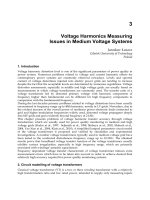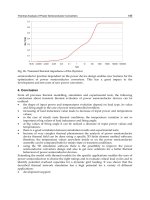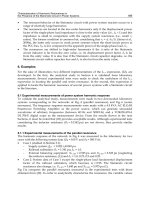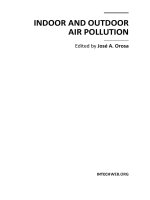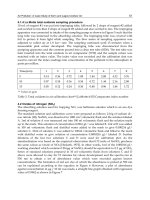Electrical Generation and Distribution Systems and Power Quality Disturbances Part 16 pptx
Bạn đang xem bản rút gọn của tài liệu. Xem và tải ngay bản đầy đủ của tài liệu tại đây (375.74 KB, 18 trang )
Some Basic Issues and Applications of
Switch-Mode Rectifiers on Motor Drives and Electric Vehicle Chargers
287
Dawande, M. S. & Dubey, G. K. (1996). Single-Phase Switch Mode Rectifiers, Proceedings of
IEEE Power Electronics, Drives and Energy Systems for Industrial Growth
, pp. 637-642,
ISBN 0-7803-2795-0
Erickson, R. & Madigan, M. (1990). Design of a Simple High-Power-Factor Rectifier Based
on the Flyback Converter,
Proceedings of IEEE Applied Power Electronics Conference
and Exposition
, pp. 792-801,
Erickson, R. W. & Maksimovic, D. (2001).
Fundamentals of Power Electronics (2nd), Kluwer
Academic Publishers, ISBN 0-7923-7270-0, Norwell Massachusetts
Farcas, C.; Petreus, D.; Simion, E.; Palaghita, N. & Juhos, Z. (2006). A Novel Topology Based
on Forward Converter with Passive Power Factor Correction,
Proceedings of
International Spring Seminar on Electronics Technology, pp. 268-272, ISBN 1-4244-0551-
3
Forest, F.; Laboure, E.; Meynard, T. A. & Huselstein, J. J. (2007). Multicell Interleaved
Flyback Using Intercell Transformers.
IEEE Transactions on Power Electronics, Vol.22,
No.5, (September 2007), pp. 1662-1671, ISSN 0885-8993
Forest, F.; Laboure, E.; Gelis, B.; Smet, V.; Meynard, T. A. & Huselstein, J. J. (2009). Design of
Intercell Transformers for High-Power Multicell Interleaved Flyback Converter.
IEEE Transactions on Power Electronics,
Vol.24, No.3, (March 2009), pp. 580-591, ISSN
0885-8993
Gataric, S.; Boroyevich, D. & Lee, F. C. (1994). Soft-Switched Single-Switch Three-Phase
Rectifier with Power Factor Correction,
Proceedings of IEEE Applied Power Electronics
Conference and Exposition
, pp. 738-744, ISBN 0-7803-1456-5
Hahn, J.; Enjeti, P. N. & Pitel, I. J. (2002). A New Three-Phase Power Factor Correction (PFC)
Scheme Using Two Single-Phase PFC Modules.
IEEE Transactions on Industry
Applications
, Vol.38, No.1, (October 2002), pp. 123-130, ISSN 0093-999
Hengchun, M.; Lee, F. C.; Boroyevich, D. & Hiri, S. (1997). Review of High Performance
Three-Phase Power-Factor Correction Circuits.
IEEE Transactions on Industrial
Electronics
, Vol.44, No.4, (August 1997), pp. 437-446, ISSN 0278-0046
Hsieh, Y. H. (2010)
Position Sensorless Permanent-Magnet Synchronous Motor Drive with Switch-
Mode Rectifier Front-End
, Master Thesis, Department of Electrical Engineering,
National Tsing Hua University, Taiwan, ROC
Huber, L.; Jang, Y. & Jovanovic, M. M. (2008). Performance Evaluation of Bridgeless PFC
Boost Rectifiers.
IEEE Transactions on Power Electronics, Vol.23, No.3, (February
2008), pp. 1381-1390, ISSN 1048-2334
Inoue, T.; Hamamura, S.; Yamamoto, M.; Ochi, A. & Sasaki, Y. (2008). AC-DC Converter
Based on Parallel Drive of Two Piezoelectric Transformers.
Japanese Journal of
Applied Physics,
Vol.47, No.5, (May 2008), pp. 4011-4014, ISSN 0021-4922
Jang, Y.; Dillman, D. L. & Javanovic, M. M. (2006). A New Soft-Switched PFC Boost Rectifier
with Integrated Flyback Converter for Stand-By Power.
IEEE Transactions on Power
Electronics,
Vol.21, No.1, (January 2006), pp. 66-72, ISSN 0885-8993
Kwon, J. M.; Kim, E. H.; Kwon, B. H. & Nam, K. H. (2008). High Efficiency Fuel Cell Power
Conditioning System with Input Current Ripple Reduction.
IEEE Transactions on
Industrial Electronics
, Vol.56, No.3, (March 2009), pp. 826-834, ISSN 0278-0046
Lamar, D. G.; Fernandez, A.; Arias, M.; Rodriguez, M.; Sebastian, J. & Hernando, M. M.
(2007). Limitations of the Flyback Power Factor Corrector as a One-Stage Power
Electrical Generation and Distribution Systems and Power Quality Disturbances
288
Supply, Proceedings of IEEE Power Electronics Specialists Conference, pp. 1343-1348,
ISBN 0275-9306
Langeslag, W.; Pagano, R.; Schetters, K.; Strijker, A. & Zoest, A. (2007). VLSI Design and
Application of A High-Voltage-Compatible SoC–ASIC in Bipolar CMOS/DMOS
Technology for AC–DC Rectifiers.
IEEE Transactions on Industrial Electronics, Vol.54,
No.5, (October 2007), pp. 2626-2641, ISSN 0278-0046
Larouci, C.; Ferrieux, J. P.; Gerbaud, L.; Roudet, J. & Barbaroux, J. (2002). Control of a
Flyback Converter in Power Factor Correction Mode: Compromise Between the
Current Constraints and the Transformer Volume,
Proceedings of IEEE Applied Power
Electronics Conference and Exposition
, Vol.2, pp. 722-727, ISBN 0-7803-7404-5
Lee, J. J.; Kwon, J. M.; Kim, E. H.; Choi, W. Y. & Kwon, B. H. (2008). Single-Stage Single-
Switch PFC Flyback Converter Using a Synchronous Rectifier.
IEEE Transactions on
Industrial Electronics
, Vol.55, No.3, (March 2008), pp. 1352-1365, ISSN 0278-0046
Li, S. H. & Liaw, C. M. (2003). Modelling and Quantitative Direct Digital Control for a DSP-
Based Soft-Switching-Mode Rectifier.
IEE Proceedings of Electric Power Applications,
Vol.150, No.1, (January 2003), pp. 21-30, ISSN 1350-2352
Li, S. H. & Liaw, C. M. (2004). Paralleled DSP-based Soft Switching-Mode Rectifiers with
Robust Voltage Regulation Control.
IEEE Transactions on Power Electronics, Vol.19,
No.4, (July, 2004), pp. 937-946, 0885-8993
Li, S. H. & Liaw, C. M. (2004). On the DSP-Based Switch-Mode Rectifier with Robust
Varying-Band Hysteresis PWM Scheme.
IEEE Transactions on Power Electronics,
Vol.19, No.6, (November, 2004), pp. 1417-1425, ISSN 0885-8993
Li, S. H.; & Liaw, C. M. (2004). Development of Three-Phase Switch-Mode Rectifier Using
Single-Phase Modules.
IEEE Transactions on Aerospace and Electronic Systems, Vol.40,
No.1, (January 2004), pp. 70-79, ISSN 0018-9251
Liaw, C. M.; Lin, Y. M.; Wu, C. H. & Hwy, K. I. (2000). Analysis, Design and Implementation
of a Random Rrequency PWM Inverter.
IEEE Transactions on Power Electronics,
Vol.15, No.5, (September 2000), pp. 843-854, ISSN 0885-8993
Lu, D. D.; Cheng, D. K. & Lee, Y. S. (2003). Single-Switch Flyback Power-Factor-Corrected
Ac/dc Converter with Loosely Regulated Intermediate Storage Capacitor Voltage,
Proceedings of 2003 International Symposium on
Circuits and Systems, pp. 264-267,
ISBN 0-7803-7761-3
Lu, D. D.; Iu, H. H.; & Pjevalica, V. (2008). A Single-Stage AC/DC Converter with High
Power Factor, Regulated Bus Voltage, and Output Voltage.
IEEE Transactions on
Power Electronics,
Vol.23, No.1, (January 2008), pp. 218-228, ISSN 0885-8993
Mahdavi, M. & Farzanehfard, H. (2009). Zero-Current-Transition Bridgeless PFC without
Extra Voltage and Current Stress.
IEEE Transactions on Industrial Electronics, Vol.56,
No.7, (July 2009), pp. 2540-2547, ISSN 0278-0046
Manh, D. C. & Guldner, H. (2006). High Output Voltage DC/DC Converter Based on
Parallel Connection of Piezoelectric Transformers,
Proceedings of International
Symposium on Power Electronics, Electrical Drives, Automation and Motion,
pp. 625-628,
ISBN 1-4244-0193-3
Matsui, K.; Yamamoto, I; Kishi, T.; Hasegawa, M.; Mori, H. & Ueda, F. (2002). A Comparison
Of Various Buck-Boost Converters and Their Application to PFC,
Proceedings of
IEEE 2002 28th Annual Conference of the
Industrial Electronics Society, Vol.1, pp. 30-36,
ISBN 0-7803-7474-6
Some Basic Issues and Applications of
Switch-Mode Rectifiers on Motor Drives and Electric Vehicle Chargers
289
Mishra, S. K.; Fernandes, B. G. & Chatterjee, k. (2004). Single Stage Single Switch AC/DC
Converters with High Input Power Factor and Tight Output Voltage Regulation,
Proceedings of IEEE 2004 30th Annual Conference of the
Industrial Electronics Society,
pp. 2690-2695, ISBN 0-7803-8730-9
Mohan, N.; Undeland, T. M. & Robbins, W. P. (2003).
Power Electronics Converters,
Applications and Design (3rd)
, John Wiley & Sons, ISBN 0-4712-2693-9, New York
Newsom, R. L.; Dillard W. C. & Nelms, R. M. (2002). Ditigal Power-Factor Correction for a
Capacitor-Charging Power Supply.
IEEE Transactions on Industrial Electronics,
Vol.49, No.5, (October 2002), pp. 1146-1153, ISSN 0278-0046
Olivera, D. S.; Barreto, L.; Antunes, F.; Silva, M.; Queiroz, D. L. & Rangel, A. R. (2009). A
DCM Three-Phase High Frequency Semi-Controlled Rectifier Feasible for Power
WECS Based on a Permanent Magnet Generator,
Proceedings of IEEE Power
Electronics Conference
, pp. 1193-1199, ISBN 2175-8603
Orabi, M. & Ninomiya, T. (2003). Nonlinear Dynamics of Power-Factor-Correction
Converter.
IEEE Transactions on Industrial Electronics, Vol.50, No.6, (December 2003),
pp. 1116-1125, ISSN 0278-0046
Papanikolaou, P. N.; Tatakis, C. E. & Kyritsis, A. C. (2005). Design of a PFC AC/DC Flyback
Converter for Low Voltage Applications,
Proceedings of 2005 European Conference on
Power Electronics and Applications,
pp. 1-10, ISBN 90-75815-09-3
Reis, M. M.; Soares, B.; Barreto, L.; Freitas, E.; Silva, C. E. A.; Bascope, R. T. & Olivera, D. S.
(2008). A Variable Speed Wind Energy Conversion System Connected to the Grid
for Small Wind Generator,
Proceedings of IEEE Applied Power Electronics Conference
and Exposition
, Vol.1, pp. 751-755, ISBN 1048-2334
Rikos, E. J. & Tatakis, E. C. (2005). Single-Stage Single-Switch Isolated PFC Converter with
Non-Dissipative Clamping.
IEE Proceedings Electric Power Applications, Vol.152,
No.2, (March 2005), pp. 166-174, ISSN 1350-2352
Sangsun, K. & Enjeti, P. N. (2002). A Parallel-Connected Single Phase Power Factor
Correction Approach with Improved Efficiency,
Proceedings of IEEE Applied Power
Electronics Conference and Exposition
, Vol.1, pp. 263-269, ISBN 0-7803-7404-5
Sangwon, L. & Sewan, C. (2010). AThree-Phase Current-Fed Push-Pull DC-DC Converter
with Active Clamp for Fuel Cell Applications,
Proceedings of IEEE Applied Power
Electronics Conference and Exposition
, pp. 1934-1941, ISBN 978-1-4244-4782-4
Shah, J. & Moschopoulos, G. (2005). Three-Phase Rectifiers with Power Factor Correction,
Proceedings of 2005 Canadian Conference on Electrical and Computer Engineering
, pp.
1270-1273, ISBN 0-7803-8885-2
Singh, B.; Singh, B. P.; & Dwivedi, S. (2006). Performance Comparison of High Frequency
Isolated AC-DC Converters for Power Quality Improvement at Input AC Mains,
Proceedings of IEEE International Conference on Power Electronics, Drives and Energy
Systems,
pp. 1-6, ISBN 0-7803-9772-X
Singh, B. & Singh, S. (2010). Single-Phase Power Factor Controller Topologies for Permanent
Magnet Brushless DC Motor Drives.
IET Power Electronics, Vol.3, No.2, (March
2010), pp. 147-175, ISSN 1755-4535
Tang, W.; Jiang, Y. H.; Verghese, G. C. &Lee, F. C. (1993). Power Factor Correction with
Flyback Converter Employing Charge Control,
Proceedings of IEEE Applied Power
Electronics Conference and Exposition
, pp. 293-298, ISBN 0-7803-0983-9
Electrical Generation and Distribution Systems and Power Quality Disturbances
290
Tanitteerapan, T. & Mori, S. (2001). An Input Current Shaping Technique for PFC Flyback
Rectifier by Using Inductor Voltage Detection Control Method,
Proceedings of IEEE
Region 10 International Conference on Electrical and Electronic Technology,
Vol.2, pp.
799-803, ISBN 0-7803-7101-1
Ting, Q. H. & Lehman,B. (2008). Coupled Input-Series and Output-Parallel Dual Interleaved
Flyback Converter for High Input Voltage Application. IEEE Transactions on Power
Electronics,
Vol.23, No.1, (January, 2008), pp. 88-95, ISSN 0885-8993
Tse, K. K.; Chung, H. S. –H.; Hui, S. Y. R. & So, H. C. (2000). A Comparative Investigation on
the Use of Random Modulation Schemes for DC/DC Converters.
IEEE Transactions
on Industrial Electronics
, Vol.47, No.2, (April 2000), pp. 253-263, ISSN 0278-0046
Uan-Zo-li, A.; Lee, F. C. & Burgos, R. (2005). Modeling, Analysis and Control Design of
Single-Stage Voltage Source PFC Converter,
Proceedings of IEEE Industry
Applications Conference
, Vol.3, pp. 1684-1691, ISBN 0-7803-9208-6
Ueda, A.; Ito, Y.; Kurimoto, Y. & Torii, A. (2002). Boost Type Three-Phase Diode Rectifier
Using Current Resonant Switch,
Proceedings of IEEE Power Conversion Conference,
Vol.1, pp. 13-18, ISBN 0-7803-7156-9
Wang, C. M. (2010)
Development of Switched-Reluctance Motor Drive with Three-Phase Switch-
Mode Rectifier Front-End
, Master Thesis, Department of Electrical Engineering,
National Tsing Hua University, Taiwan, ROC
Wang, K.; Lee, F. C. & Boroyevich (1994). Soft-Switched Single-Switch Three-Phase Rectifier
with Power Factor Correction,
Proceedings of IEEE Applied Power Electronics
Conference and Exposition
, pp. 738-744, ISBN 0-7803-1456-5
Wolfs, P. & Thomas, P. (2007). Boost Rectifier Power Factor Correction Circuits with
Improved Harmonic and Load Voltage Regulation Responses,
Proceedings of IEEE
Power Electronics Specialists Conference
, pp. 1314-1318, ISBN 0275-9306
Youssef, N. B. H.; Al-Haddad, K. & Kanaan, H. Y. (2008). Implementation of a New Linear
Control Technique Based on Experimentally Validated Small-Signal Model of
Three-Phase Three-Level Boost-Type Vienna Rectifier.
IEEE Transactions on
Industrial Electronics
, Vol.55, No.4, (April 2008), pp. 1666-1676, ISSN 0278-0046
Zhang, R.; Lee, F. C. & Boroyevich, D. (2000). Four-Legged Three-Phase PFC Rectifier with
Fault Tolerant Capability,
Proceedings of IEEE Power Electronics Specialists Conference,
Vol.1, pp. 359-364, ISBN 0275-9306
Zheng, Y. & Moschopoulos, G. (2006). Design Considerations for a New AC-DC Single Stage
Flyback Converter,
Proceedings of IEEE Applied Power Electronics Conference and
Exposition
, pp. 400-406, ISBN 0-7803-9547-6
0
Battery Charger with Power Quality Improvement
Dylan Dah-Chuan Lu
School of Electrical and Information Engineering
The University of Sydney
Australia
1. Introduction
Battery storage has long been used in many applications such as portable multimedia player,
mobile phone, portable tool, laptop computer, emergency exit sign, uninterruptible power
supply and transportation auxiliary supply. Owing to the advancement of material science
and packaging technologies, newer batteries with higher energy density and reliability have
been produced. Batteries are now being used in higher power applications such as electric
vehicles (EV), renewable energy systems and microgrid. Examples of high power batteries
are Lithium-ion and Zinc-Bromine which are rated at kilo-watt range and mega-watt range
respectively (Roberts, 2009). At such high power level, these batteries will have significant
impact on the grid.
Power quality is one of major impacts to the grid when these high power batteries are
charging. Since the battery is working at DC level, rectification (i.e., AC to DC conversion)
is required. For the traditional design of rectifiers, for example diode-capacitor rectifier
and phase-controlled thyristor rectifier, the current drawn by these battery chargers causes
high total harmonic distortion (THD) and poor power factor (PF). This results in heating of
transformer and cables and tripping of circuit breakers (Bass et al., 2001; Gomez & Morcos,
2003). Switching AC/DC converters with active power factor correction (PFC) is able to
reduce THD and improve PF effectively. This technique has been applied to battery charger
for electric vehicles (Mi, et al., 2003).
Power electronics enables intelligent control of battery charger such that the power
quality of the grid can be improved. One example is the vehicle-to-grid (V2G) reactive
power compensation. A mathematical analysis of an electric vehicle charger based on a
full-bridge inverter/rectifier and a half-bridge bi-directional dc/dc converter is presented
(Kisacikoglu, et al. (2001)). The charger is abl e to handle different PQ conditions at different
operation modes. A relationship between dc link ripple and reactive power flow direction
is also derived. The analysis shows that while the charger can achieve reactive power
compensation, one has to set a limit on the four-quadrant power transfer of the charger due
to the stresses on the components.
Active power filters (APF) have been developed primarily to compensate the harmonic and
reactive power components of line current generated by the nonlinear loads and to improve
the power quality of the grid ( El-Haborouk et al., 2000; Singh et. al ., 1999). Current-fed type
APF uses an inductor for reactive power compensation while voltage-fed type APF uses a
capacitor.
12
2 Will-be-set-by-IN-TECH
It is possible to integrate an APF function into a battery charger. For example, an
uninterruptible power supply (UPS) with integrated APF capability has been proposed
(C C.& Manjrekar, 2005; W u & Jou, 1995). In both cases, a voltage-fed type APF is used and
the battery is connected in parallel with the capacitor. For UPS, the battery is stationary; it
always stays with the power supply system and operates in stand-by mode for emergency
situation. For other battery charger such as EV charger, the battery is non-stationary; it
only connects to the charger when it needs to be charged. Therefore the configuration
where the capacitor is installed in parallel with the battery terminals, as suggested earlier
(C C.& Manjrekar, 2005; Wu & Jou, 1995), cannot be used. It is because when the batte ry is
removed from the charging terminals, a potential difference between the capacitor and the
battery will be created. The worst scenario happens when next time the battery is depleted
and putting back to the charging terminals to recharge, it has lower voltage than that of the
capacitor. If one simply connects the battery to the charging terminals, a surge discharge
current from the capacitor would occur. This will damage the circuitry, connectors and battery
due to this high current.
This chapter presents a simple and improved battery charger system with power quality
improvement function. It solves the aforementioned parallel capacitor-battery issue by a
proposed equal charge concept. And the circuit is simplified by integrating a two-switch
dc/dc converter with a full-bridge converter/inverter and using only one inductor. The
chapter is organized as follows. The proposed charger and its operation will be described
in Section 2. The equal charge concept will be explained in Section 3. Design considerations of
the charger will be given in Secion 4. Simulation results will be reported in Section 5 followed
by conclusions in Section 6.
2. Proposed battery charger with power quality enhancement
2.1 Circuit description
Fig. 1 shows the proposed battery charger system with power factor correction (PFC)
capability. It consists of an integrated full-bridge inverter/converter (S1 to S4), an inductor
L
o
, a capacitor C
o
and a switch (S5). As compared to the two inductors and six switches used
in the converter introduced in (Kisacikoglu, et al. (2001)), the proposed co nverter has fewer
component counts. In summary, when charging the battery, it operates as a buck converter
with input current shaping for PFC and when discharging the battery, it operates as a boost
converter with reactive power compensation.
2.2 Circuit operation and analysis– battery charging
The converter operates as a buck (step-down) converter during charging mode. As the input
voltage v
in
has a general expression of V
m
sinωt, its value chang es from 0V to V
m
. Therefore
current will flow from the grid to the converter to charge the battery only when the input
voltage is h igher than the battery voltage V
batt
. The current flow is controlled by the power
switches S1 to S4 operating at high switching frequency and shaped by the inductor L
o
.Now
suppose at certain instant the input voltage at node A is higher than node B and v
in
> V
batt
is satisfied, S1 and S4 turn on to allow input current to flow into the circuit, as shown in Fig.
2(a). The voltage applied across the inductor is v
in
− V
Co
and the inductor is charging linearly
with a rate equals
di
Lo
dt
=
v
in
− V
Co
L
o
(1)
292
Electrical Generation and Distribution Systems and Power Quality Disturbances
Battery Charger with Power Quality Improvement 3
S1
S2
S3
S4
+
+
L
o
C
o
V
batt
✛
❄
Gate Driver
✛
V
Co
S1 to S5
✛
v
in
v
in
✛
S5
Micro-
controller
AB
−+ V
Lo
Fig. 1. Proposed battery charger with power quality improvement functions.
The inductor L
o
and capacitor C
o
ensure the high frequency current ripple to the battery has
reduced. After certain interval, we need to reset the inductor to prevent it from saturation.
There are a number of ways t o discharge the inductor current:
1. Turn on S1 and S2 to provide a free wheeling path with V
Lo
= −V
batt
2. Turn on S3 and S4 to provide a free wheeling path with V
Lo
= −V
batt
3. Turn on S2 and S3 to provide a discharging path for the inductor with V
Lo
= −V
batt
− v
in
Fig. 2(b) shows the current path for option 2 as described above while Fig. 2(c) shows option
3. Comparing to the first two options, the third option with input voltage putting in series
with the battery for discharging of inductor current would achieve a faster response in case a
sudden decrease in the output loading c ondition occurs. But at the same time, comparing to
options 1 and 2, option 3 will cause more switching losses because all four switches have to be
in action during this mode while for the other two options only three switches are involved.
Similiarly for opposite half of the line cycle, i.e., node B has higher potential than node A,
and if v
in
> V
batt
is satisfied, S2 and S3 turn on to allow input cur rent to flow into the circuit
and charge the inductor. For the inductor discharging period, again there are three options to
continue the inductor current flow similiar to the previous description.
Apart from charging the battery, the converter in this mode has to provide power factor
correction (PFC) according to the international standard such as IEC 61000-3-2 when the
converter draws more than 75W of power from the ac line. To achieve PFC, L
o
is the main
component to shape the input current and it can work in all three modes to achieve the PFC
function, i.e. discontinuous conduction mode (DCM), boundary conduction mode (BCM)
or continuous conduction mode (CCM). For DCM operation, the input current is shaped
293
Battery Charger with Power Quality Improvement
4 Will-be-set-by-IN-TECH
S1
S2
S3
S4
+
L
o
C
o
v
in
S5
AB
−+
V
Lo
✻
✲
❄
✛
✻
✲
✛
(a) Charging of inductor
S1
S2
S3
S4
+
L
o
C
o
v
in
S5
AB
−+
V
Lo
✲
❄
✛
✻
✲
✛
(b) Discharging of inductor through S3 & S4
S1
S2
S3
S4
+
L
o
C
o
v
in
S5
AB
−+
V
Lo
✲
❄
✛
✲
✛
✻
(c) Discharging of inductor through S2 & S3
Fig. 2. Equivalent circuits for charging mode operation
294
Electrical Generation and Distribution Systems and Power Quality Disturbances
Battery Charger with Power Quality Improvement 5
automatically as it is given by
i
in.avg
(t)=
D
2
T
s
[v
in
(t) − V
batt
]
2L
o
(2)
We can observe from (2) that the average input current, i
in,avg
(t), of the buck operating
mode follows in phase and closely with input voltage v
in
if duty cycle D is constant but it
is negatively offseted so there is a distortion in the current. And the lower the V
batt
, the better
the power factor (PF) this mode can achieve as the conduction angle increases with reducing
battery voltage for a given input line voltage. For BCM and CCM operations, the input current
has to be sensed and controlled to follow the shape of the input voltage to achieve high PF. A
peak current mode controller can be used for both BCM and CCM operations.
2.3 Circuit operation and analysis – battery discharging
The converter operates as a boost (step-up) converter during discharging mode. Unlike the
buck mode operation, current from the battery can always flow to the ac line (or grid), v
in
,via
the boost action. Switch S5 remains closed in this mode and the inductor L
o
serves as energy
storage element as well as shaping the current for reactive power compensation. Suppose
at certain instant the potential at node A is higher than node B. To charge L
o
, we can turn
on either switches pair S1/S2 or switches pair S3/S4. We will discuss what the difference
is by switching particular pair soon but suppose at this point we select pair S3/S4. Once
the switches pair is turned on, a voltage equals V
Lo
= −V
batt
is applied across the inductor.
Therefore the inductor current flows from the battery to the switches with a rate equals
di
Lo
dt
=
−
V
batt
L
o
(3)
Note that the capacitor C
o
does help to reduce the current ripple on the battery and serve
to pr ovide a fast response as usually the battery is of slow response, in particular to sudden
surge of current demand. After a certain interval, the inductor h as to be reset. To reset L
o
,a
voltage which equals V
Co
− v
in
needs to apply across the inductor and its rate of discharge
equals
di
Lo
dt
=
V
Co
− v
in
L
o
(4)
To achieve this, S3 is turned off and S1 is turned on with S4 remains closed, as shown in Fig.
3(b). From this transition w e can observe that two switches are involved. If S1 and S2 were
turned on first previously for the inductor charging, then S2 will turn off and S4 will turn
on with S1 remains closed for the discharging interval. Hence there are still two switches
involved.
Apart from discharging the battery, the converter i n this mode is able to improve the power
quality of the grid. To achieve high power factor, L
o
is the main component to shape the i nput
current and it can work again in all three modes to achieve the PFC function, i.e. DCM, BCM
and CCM. The inductor current waveform is shown in Fig. 4. It works in DCM operation. The
instantaneous average inductor current is equal to the instantaneous average input current,
which is given by
¯
i
ac
(t)=
V
batt
2L
o
d(t)[d(t)+d
1
(t)] T
s
(5)
295
Battery Charger with Power Quality Improvement
6 Will-be-set-by-IN-TECH
S1
S2
S3
S4
+
L
o
C
o
v
in
S5
AB
−+
V
Lo
✛ ✛
✲
❄
✻
✲
(a) Charging of inductor
S1
S2
S3
S4
+
L
o
C
o
v
in
S5
AB
−+
V
Lo
❄
✛ ✛
✲
❄
✻
✲
(b) Discharging of inductor
Fig. 3. Equivalent circuits for discharging mode operation
Using voltage-second balance on L
o
, the inductor discharging period, d
1
(t),isexpressedas
d
1
(t)=
V
batt
v
in
(t) − V
batt
d
1
(t) (6)
Therefore the instantaneous average input current has the final form as follows
¯
i
ac
(t)=
V
batt
T
s
2L
o
d
2
(t) ·
v
in
(t)
v
in
(t) − V
batt
(7)
As it can be seen from (7), the last term of on the right hand side is non-linear due to the
time-varying input voltage v
in
(t). Hence the duty cycle has to vary in response to this varying
voltage to maintain high power factor. In order to achieve unity power factor, i.e.,
¯
i
ac
(t)=
296
Electrical Generation and Distribution Systems and Power Quality Disturbances
Battery Charger with Power Quality Improvement 7
✻
✲
✲
Gate drive voltage
ON OFF
i
Lo
d(t)T
s
✛ ✲
✲ ✛
d
1
( t)T
s
t
t
Fig. 4. Gate drive voltage and inductor current waveforms at the discharging mode.
v
in
(t)/R
eq
where R
eq
is the equivalent resistance of the converter, the duty cycle ne eds to be
expressed as
d
(t)=
1
v
in
(t) − V
batt
(8)
Fig. 5 shows the required duty cycle over a half line period, given V
batt
=72V and
v
in
(t)=340sin(πt). It can be observed from the same figure that at the beginning and near
the end of the line cycle, the duty cycle goes to infinity which is impossible in reality. This
happens because, as it can be seen from (6) that, when v
in
(t) ≤ V
batt
is satisfied the boost
mode is not operating as the input voltage is not enough to reset the inductor. To prevent
this from happening, the simpliest way is to have duty cycle equals zero but this will create
current distortion as will be shown from simulation later on.
3. Equal charge concept
3.1 Principle of operation
The equal charge concept is to deal with non-stationary battery where unequal charges are
found on the battery and the battery charger. Since the battery will be plugged into the battery
charger for charging in parallel, a potential difference between the battery and charger will
create a large cur rent (or surge current) flow at the i nstant of connection. The m agnitude of
this current depends on the state-of-charge o n the battery; i t ranges from slightly discharged
to fully discharged depending on what type of battery the machine us es and how the battery
is used. The larger the potential difference between the two points, the larger the magnitude of
the surge current will flow. This could damage the connectors or cabling and other devices in
which the surge current passes through. In order to deal with this problem, the equal concept
is introduced. The idea is simple: it is to bring the potential difference between the charger
and the battery to zero before the electrical connection and as a result there will be no surge
current flow. The procedure is explained, with the aid of Fig. 1, as follows: Firstly, switch
S5 has to be open. Then the battery is connected to the charger. The voltage of the battery,
V
batt
is sensed and sent to the micro-controller as a reference voltage. The micro-controller
compares this reference voltage and the voltage on C
o
.IfV
Co
> V
batt
is satisfied, then the
charger operates in discharging mode (i.e., boost mode) to take away some charge on C
o
until
its voltage is equal to V
batt
.IfV
Co
< V
batt
is satisfied, then the charger operates in charging
297
Battery Charger with Power Quality Improvement
8 Will-be-set-by-IN-TECH
Fig. 5. Duty cycle changes in response to varying input voltage in discharging mode.
mode (i.e., buck mode) to charge up C
o
until its voltage is equal to V
batt
. After the equal charge
process has completed, S5 can be closed and the charger operation can be continued.
3.2 Simulation results
To illustrate the effectiveness of the equal charge concept, a series of simulations by a free
circuit simulator LTSpiceIV (Linear Technology) have been carried out. The test circuit is
based on an open-loop bi-directional dc/dc converter (S1, S3 and L2) with an output capacitor
C1, a switch S2 mimiking a relay and a battery model (L1, R1 and V2), as shown in Fig. 6. I n
the first scenario, the effect of large surge current discharge if the voltages are not m atached
is shown. Th e power converter is not in operation but the output voltage at C1 is at 200V
initially. The battery before the connection is at 72V. When S2 is closed, a large surge current
with peak value at 630A is produced, as shown in Fig. 7. Although it only lasts for a short
duration and the current drops to 0A after 5ms, it has enough energy to create a spark at the
switch and could melt and wear the joint after a period of operation. In the second scenario,
the equal charge concept is realized. The duty cycles of the bi-directional converter are set
to produce an output of 74V before connecting the battery, as shown in Fig. 8. After S2 is
closed, a maximum current of only 10A is generated and it drops to 5A to charge the battery.
Of course one can use the same voltage as that of the battery before battery connection but in
this scenario the capability of controlling of the output voltage to control the charging current
298
Electrical Generation and Distribution Systems and Power Quality Disturbances
Battery Charger with Power Quality Improvement 9
Fig. 6. Test circuit to show equal charge concept.
is demonstrated. Since this converter works in an open-loop condition, the output voltage
drops to 73V. But in a closed-loop control condition, the voltage can be regulated. Despite of
this, it is still possible to observe that the charging current is limited by the resistance of the
relay S2 and the internal resistance of the battery. Therefore the charging current is obtained
as (73-72)V/(0.1+0.1)Ω = 5A. In order to control the charging current, another option is to
replace the relay by a power bipolar junction transistor (BJT). However, apart from additional
control circuit which increases the cost, the necessary saturation voltage across the collector
and emittor also imposes a minimum charging current to the battery. Therefore the control is
simplified by the proposed voltage control of the converter.
4. Design considerations
4.1 Practical power stage design
The simplified circuit diagram as shown in Fig. 1 and the previous explanation of the battery
charging and discharging are based on the fullly bi-directional current blocking capability of
the four switches. However both MOSFET and IGBT which are the commonly used power
devices cannot be used as such because of their partial current blocking capacbility. For
MOSFET, although current can flow in both directions, the body diode cannot be externally
controlled. For IGBT, the current can only flow in one direction. In order to achi eve the said
bi-directional current blocking capability with minimum component count, Fig. 9 shows a
practical power stage design. It consists of four IGBTs and two MOSFETs. Two IGBTs (i.e.
S1/S2 and S3/S4) form a pair to allow bi-directional current blocking capability. Since an
IGBT pair is inserted in each leg and controls the current direction at any time of the input
voltage, one can simply use a MOSFET for the other part of each leg instead of another IGB T
pair to save part and cost. With this circuit configuration it is convenient to control the current
299
Battery Charger with Power Quality Improvement
10 Will-be-set-by-IN-TECH
Fig. 7. Output waveforms without equal charge implemented.
Fig. 8. Output waveforms with equal charge implemented.
direction. During the battery charging phase, switches S2, S4 and S6 (body diode) will come
to operation during the positive half line cycle and S1, S3 and S5 (body diode) for the negative
half cycle. During the battery discharging phase, switches S1, S3 and S6 will come to operation
during the positive half line cycle while S2, S4 and S5 for the negative half cycle.
4.2 Current control
For the control stage as shown in Fig. 1, only voltage sensing at the output of the converter and
the battery are shown. However, in practice it is useful to include a current sensing device to
measure the battery current. It is because as mentioned earlier different battery has different
charging/discharging profile. The current sensor and the micro-controller will work together
300
Electrical Generation and Distribution Systems and Power Quality Disturbances
Battery Charger with Power Quality Improvement 11
S2S1
❥
S3 S4
❨
+
+
L
o
C
o
V
batt
v
in
❥
❨
S5
S5
AB
−+ V
Lo
✛ ✛
S6
✛
Fig. 9. Practical design of the power stage of the proposed battery charger.
to maintain the battery current profile, as well as to achieve current protection functions such
as over-current protection (OCP). A current sensor will also help implement s ome superfast
charging algorithm by constantly monitoring the battery current.
4.3 Need of paralleled capacitance
The capacitor placed in parallel with the battery is important, not only for achieving a faster
response to compensate for the slow response of the battery current in response to fast current
demand, but also for reducing the current ripple on the battery. Fig. 10(a) shows the battery
charger in charging mode without a p aralleled capacitor. Under this situation, the inductor
current equals the battery charging current and so as the ripple current. This ripple current
will heat up the battery due to the internal re sistance. This results in shorter battery lifetime.
Fig. 10(b) shows the same working condition but a capacitor is placed in parallel with the
battery. Now, because the capacitor absorbs the current ripple from the inductor current, the
current ripple on the battery is dramatically reduced. Note that this capacitor not only d oes
reduce the high frequency ripple but also the low frequency ripple. But in general the high
frequency ripple, especially when the inductor works in DCM, causes more losses than that
of the low frequency ripple.
5. Simulation results of the proposed charger
To verify the power quality capability of the proposed battery charger, a series of simulations
based on Fig. 1 have been carried out. The circuit parameters used are as follows: L
o
=50μH,
C
o
= 2200μF, v
in
=240Vrms, V
batt
= 72V with 1Ω i nternal resistance and switching frequency
f
s
= 100kHz. The inductor is working in DCM. Fig. 11 shows the key waveforms of the
converter when it is working in charging (buck) mode over a few line period. It can be seen
that there is an input distortion due to the fact that the input voltage is less than the battery
voltage for some time of the line cycle, as discussed eariler. However, when input voltage is
greater than the battery voltage, the inductor L
o
shapes the input current to follow the input
voltage. Therefore it is possible for the proposed converter to achieve high power factor in
buck operating mode. Fig. 12 shows the key waveforms of the converter when it is working
in discharging (boost) mode over a half line period. It has been explained in Section 2.3 that
301
Battery Charger with Power Quality Improvement
12 Will-be-set-by-IN-TECH
(a) Without a capacitor
(b) W ith a capacitor
Fig. 10. The importance of capacitor placed in parallel with the battery.
for boost mode operation current can always flow to the ac line. However, the input voltage
is lower than the battery voltage for some time during each line cycle and the boost mode
requires the input ac voltage is larger than the battery voltage for proper operation, otherwise
the inductor L
o
cannot be reset and it will saturate the inductor during this period. Therefore
to protect the inductor from saturation the converter stops operation until v
in
is equal to and
above V
batt
. In the current setting, the input voltage angle, θ, for this equality is calculated as
θ
= sin
−1
V
batt
V
m
= sin
−1
72
340
= 12
◦
302
Electrical Generation and Distribution Systems and Power Quality Disturbances
Battery Charger with Power Quality Improvement 13
Fig. 11. Power factor correction (PFC) performed by the proposed charger during charging
(buck) mode.
Fig. 12. The proposed charger achieves high power factor during discharging (boost) mode.
where V
m
is the peak input ac voltage. The time expression of the input voltage angle is hence
12
◦
/180
◦
× 10ms = 0.67ms. The introduction of dead time of input current will certainly
create current distortion but again with the good input current shaping capability during the
conduction period the converter still can deliver high quality current to the ac line. In order to
further improve the input current quality during the discharging mode, the converter can run
in BCM or CCM and use hysteresis current control or average current mode control to track
the input current to follow the input voltage. In such case, variable switching fr equency will
be used.
303
Battery Charger with Power Quality Improvement
14 Will-be-set-by-IN-TECH
6. Conclusion
In this chapter, a simple and integrated battery charger with power quality improvement
is presented. It can draw and deliver high quality current from and to the ac line by the
input current shaping technique on the inductor. Circuit operation analysis and design
considerations of the power converter have been discussed. A equal charge concept together
with practical implementation has been explained. Simulation results have been reported to
verify the theoretical analysis.
7. References
Bass, R., Harley, R., Lambert, F., Rajasekaran, V. & Pierce, J. (2001). R esidential harmonic
loads and ev charging, Proceedings of Power Engineering Society Winter Meeting, IEEE,
Atlanta, USA, pp. 803–808.
C C., Y. & Manjrekar, M. (2005). A reconfigurable uninterruptible power supply system
for multiple power quality applications, Proceedings of IEEE Applied Power Electronics
Conference and Exposition, IEEE, Milwaukee, USA, pp. 1824–1830.
El-Haborouk,M., Darwish,M. & Mehta, P. (2000). A ctive power filters: A review, IEE
Proceedings, Electric Power Applications Vol. 147(No. 5): 403–413.
Gomez, J. & Morcos, M. (2003). Impact of ev battery chargers on the power quality of
distribution systems, IEEE Transactions on Power Delivery Vol. 18(No. 3): 975–981.
Kisacikoglu,M., Ozpineci, B. & Tolbert, L. (2010). Effects of v2g reactive power compensation
on the component selection in an ev or phev bidirectional charger, Proceedings of IEEE
Energy Conversion Congress and Exposition, IEEE, Knoxville, USA, p. 870=876.
Mi, N., Sasic, B. andMarshall, J. & Tomasiewicz, S. (2003). A novel economical single
stage battery charger with power factor correction, Proceedings of IEEE Applied Power
Electronics Conference and Exposition, IEEE, USA, pp. 760–763.
Roberts, B. (2009). Active power filters: A review, IEEE Power and Energy Magazine Vol . 7 ( N o .
4): 32–41.
Singh, B., Al-Haddad, K. & Chandra, A. (1999). A review of acti ve filters for power quality
improvement, IEEE Transactions on Industrial Electronics Vol. 46(No. 5): 960–971.
Wu, J C. & Jou, H L. (1995). A new ups scheme provides harmonic s uppression and input
power factor correction, IEEE Transactions on Industrial Electronics Vol. 42(No. 6): 629–
635.
304
Electrical Generation and Distribution Systems and Power Quality Disturbances
